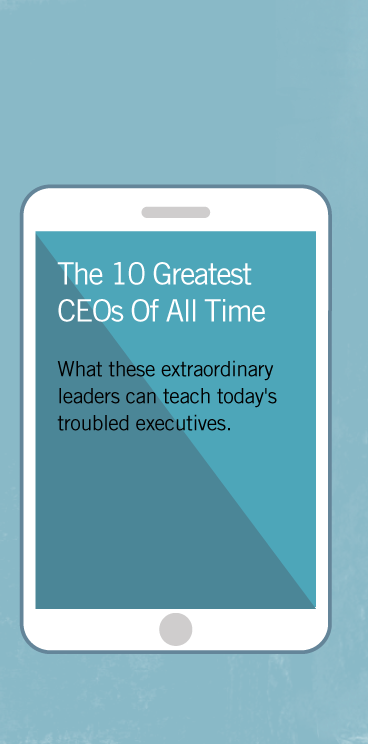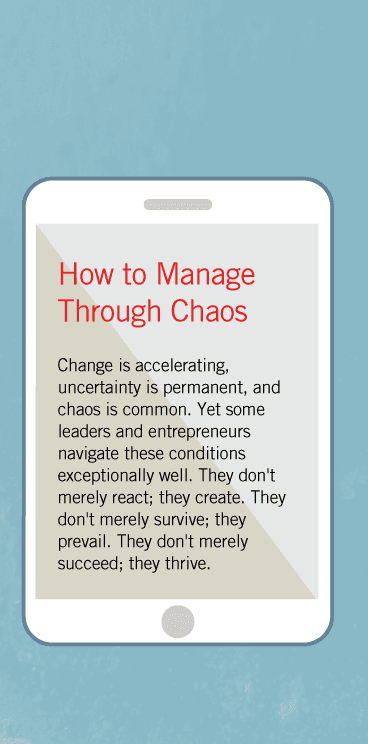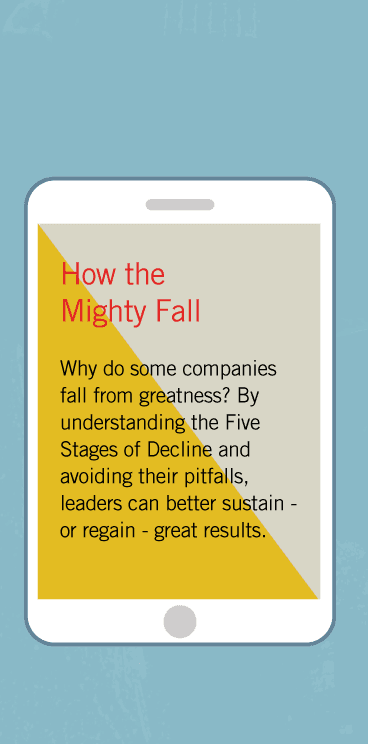How the Mighty Fall
In Autumn 2004, I received a phone call from Frances Hesselbein, founding president of the Leader to Leader Institute.
"The Conference Board and the Leader to Leader Institute would like you to come to West Point to lead a discussion with some great students," she said.
"And who are the students?" I asked, envisioning perhaps a group of cadets.
"Twelve U.S. Army generals, 12 CEOs, and 12 social sector leaders," explained Hesselbein. "They'll be sitting in groups of six, two from each sector—military, business, social—and they'll really want to dialogue about the topic."
"And what's the topic?"
"Oh, it's a good one. I think you'll really like it." She paused. "America."
America? What could I possibly teach this esteemed group about America? Then I remembered what one of my mentors, Bill Lazier, told me about effective teaching: Don't try to come up with the right answers; focus on coming up with good questions.
I pondered and puzzled and finally settled upon the question: Is America renewing its greatness, or is America dangerously on the cusp of falling from great to good? While I intended the question to be rhetorical (I believe America carries a responsibility to continuously renew itself, and it has met that responsibility throughout its history), the West Point gathering nonetheless erupted into an intense debate. Half of the participants argued that America stands as strong as ever, while the other half contended that America teeters on the edge of decline.
History shows, repeatedly, that the mighty can fall. The Egyptian Old Kingdom, the Chou Dynasty, the Hittite Empire—all fell. Athens fell. Rome fell. Even Britain, which stood a century before as a global superpower, saw its position erode. Is that the U.S.'s fate? Or will America always find a way to meet Lincoln's challenge to be the last best hope of Earth?
At a break, the chief executive of one of America's most successful companies pulled me aside. "I've been thinking about your question in the context of my company all morning," he said. "We've had tremendous success in recent years, and I worry about that. So what I want to know is: How would you know?"
"What do you mean?" I asked.
"When you are at the top of the world, the most powerful nation on Earth, the most successful company in your industry, the best player in your game, your very power and success might cover up the fact that you're already on the path of decline." That question—how would you know?—captured my imagination and became part of the inspiration for this book.
THE SILENT CREEP OF DOOM
At our research lab, we'd already been discussing the possibility of a project on corporate decline, in part because some of the great companies we'd profiled in the books Good to Great and Built to Last had subsequently lost their positions of prominence. On one level this fact didn't cause much angst; just because a company falls doesn't invalidate what we can learn by studying that company when it was at its historical best.
But on another level I found myself becoming increasingly curious: How do the mighty fall? If some of the greatest companies in history can go from iconic to irrelevant, what might we learn by studying their demise, and how can others avoid their fate? I returned from West Point inspired to turn idle curiosity into an active quest. Might it be possible to detect decline early and reverse course—or even better, might we be able to practice preventive medicine?
I've come to see institutional decline like a disease: harder to detect but easier to cure in the early stages; easier to detect but harder to cure in the later stages. An institution can look strong on the outside but already be sick on the inside, dangerously on the cusp of a precipitous fall.
Consider the rise and fall of one of the most storied companies in U.S. business history.
In the wake of the 1906 San Francisco earthquake, A.P. Giannini, founder of the fledgling Bank of Italy, found himself at odds with other bankers who wanted to impose up to a six-month moratorium on lending. His response: putting a plank across two barrels right in the middle of a busy pier and opening for business. "We are going to rebuild San Francisco," he proclaimed.
Giannini lent to the little guy when the little guy needed it most, and his bank, later renamed Bank of America (BAC), gained momentum—little guy by little guy, loan by loan, deposit by deposit, branch by branch, expanding ever outward from San Francisco. By 1945 it had surpassed Chase National Bank as the largest commercial bank in the world, and by the late 1970s it had grown to more than a thousand branches in more than a hundred countries. Along the way it became admired not just for its size but also for its quality of management. (Note of clarification: In 1998, NationsBank acquired Bank of America and took the name; the Bank of America described here is a different company than NationsBank.)
Entering the 1980s, Bank of America held a revered position and was widely regarded as one of the greatest companies in the world. Within eight years it would post some of the biggest losses in U.S. banking history, rattle the financial markets to the point of briefly depressing the U.S. dollar, watch its cumulative stock performance fall more than 80% behind the general stock market, face a serious takeover threat from a rival California bank, cut its dividend for the first time in 53 years, sell off its corporate headquarters to help meet capital requirements, see the last Giannini family board member resign in outrage, oust its chief executive, bring a former CEO out of retirement to save the company, and endure a barrage of critical articles in the business press, with titles such as "The Incredible Shrinking Bank" and "Better Stewards (Corporate and Otherwise) Went Down on the Titanic." Anyone predicting such a fall as the decade began would have been viewed as a pessimistic outlier.
If a company as powerful and well-positioned as Bank of America in the late 1970s could fall so far, so hard, so quickly, then any company can. If companies such as Motorola (MOT), Circuit City (CCTYQ), and Fannie Mae (FNM)—icons that once served as paragons of excellence—can succumb to the forces of gravity, then no one is immune. If companies such as Zenith and A&P, once the unquestioned champions in their fields, can plummet from great to irrelevant, then we should be wary about our own success.
Every institution is vulnerable, no matter how great. There is no law of nature that the most powerful will inevitably remain at the top. Anyone can fall, and most eventually do.
But all is not gloom. By understanding the five stages of decline we uncovered in our research for How the Mighty Fall, leaders can substantially increase the odds of reversing decline before it is too late—or even better, stave off decline in the first place. Decline can be avoided. The seeds of decline can be detected early. And decline can be reversed (as we've seen with notable cases such as IBM (IBM), Hewlett-Packard (HPQ), Merck (MRK), and Nucor (NUE)). The mighty can fall, but they can often rise again.
FIVE STAGES OF DECLINE
I feel a bit like a snake that swallowed two watermelons at once. I'd started this project as a diversion to engage my pen while completing the research for my next full-sized book on what it takes to endure and prevail when the world around you spins out of control (based on a six-year research project with my colleague Morten Hansen). But after my West Point visit, the question of how the mighty fall evolved into a topic of passionate curiosity channeled into a research effort that led to this small book.
In one sense, my research colleagues and I have been studying failure and mediocrity for years. Our research methodology relies on contrast, studying those companies that became great in contrast to those that did not and asking: "What's different?" But we had not explicitly delved into the question: Why do some great companies fall, and how far can a company fall and still come back? I began to joke with my colleagues: "We're turning to the dark side."
We had a substantial amount of data collected from prior research studies, consisting of more than 6,000 years of combined corporate history. From this data set, we identified a set of once-great companies that fell and constructed a set of "success contrasts" that had risen in the same industries during the era when our primary study companies declined. Our principal effort focused on a two-part question: What happened leading up to the point at which decline became visible, and what did the company do once it began to fall?
Our comparative and historical analysis yielded a descriptive model of how the mighty fall that consists of five stages that proceed in sequence. And here's the really scary part: You do not visibly fall until Stage 4! Companies can be well into Stage 3 decline and still look and feel great, yet be right on the cusp of a huge fall. Decline can sneak up on you, and—seemingly all of a sudden—you're in big trouble.
Even so, I ultimately see this as a work of well-founded hope. With a road map to decline in hand, institutions heading downhill might be able to apply the brakes early and reverse course. We've found companies that recovered—in some cases, coming back even stronger—after having crashed down into the depths of Stage 4. Our research indicates that organizational decline is largely self-inflicted, and recovery largely within our own control. So long as you never fall all the way to Stage 5, you can rebuild.
While a full exploration of the five stages is beyond the scope of this excerpt, here is a brief summary:
STAGE 1: HUBRIS BORN OF SUCCESS
Great enterprises can become insulated by success; accumulated momentum can carry an enterprise forward for a while, even if its leaders make poor decisions or lose discipline. Stage 1 kicks in when people become arrogant, regarding success virtually as an entitlement, and they lose sight of the true underlying factors that created success in the first place. When the rhetoric of success ("We're successful because we do these specific things") replaces penetrating understanding and insight ("We're successful because we understand why we do these specific things and under what conditions they would no longer work"), decline will very likely follow. Luck and chance play a role in many successful outcomes, and those who fail to acknowledge the role luck may have played in their success—and thereby overestimate their own merit and capabilities—have succumbed to hubris.
The best leaders we've studied never presume they've reached ultimate understanding of all the factors that brought them success. For one thing, they retain a somewhat irrational fear that perhaps their success stems in large part from fortuitous circumstance. Suppose you discount your own success ("We might have been just really lucky/were in the right place at the right time/have been living off momentum/have been operating without serious competition") and thereby worry incessantly about how to make yourself stronger and better-positioned for the day your good luck runs out. What's the downside if you're wrong? Minimal: If you're wrong, you'll just be that much stronger by virtue of your disciplined approach. But suppose instead you succumb to hubris and attribute success to your own superior qualities ("We deserve success because we're so good/so smart/so innovative/so amazing"). What's the downside if you're wrong? Significant. You just might find yourself surprised and unprepared when you wake up to discover your vulnerabilities too late.
STAGE 2: UNDISCIPLINED PURSUIT OF MORE
Hubris from Stage 1 ("We're so great, we can do anything!") leads right to Stage 2, the Undisciplined Pursuit of More—more scale, more growth, more acclaim, more of whatever those in power see as "success." Companies in Stage 2 stray from the disciplined creativity that led them to greatness in the first place, making undisciplined leaps into areas where they cannot be great or growing faster than they can achieve with excellence—or both. When an organization grows beyond its ability to fill its key seats with the right people, it has set itself up for a fall. Although complacency and resistance to change remain dangers to any successful enterprise, overreaching better captures how the mighty fall.
Discontinuous leaps into areas in which you have no burning passion is undisciplined. Taking action inconsistent with your core values is undisciplined. Investing heavily in new arenas where you cannot attain distinctive capability, better than your competitors, is undisciplined. Launching headlong into activities that do not fit with your economic or resource engine is undisciplined. Addiction to scale is undisciplined. To neglect your core business while you leap after exciting new adventures is undisciplined. To use the organization primarily as a vehicle to increase your own personal success—more wealth, more fame, more power—at the expense of its long-term success is undisciplined. To compromise your values or lose sight of your core purpose in pursuit of growth and expansion is undisciplined.
STAGE 3: DENIAL OF RISK AND PERIL
As companies move into Stage 3, internal warning signs begin to mount, yet external results remain strong enough to "explain away" disturbing data or to suggest that the difficulties are "temporary" or "cyclic" or "not that bad," and "nothing is fundamentally wrong." In Stage 3, leaders discount negative data, amplify positive data, and put a positive spin on ambiguous data. Those in power start to blame external factors for setbacks rather than accept responsibility. The vigorous, fact-based dialogue that characterizes high-performance teams dwindles or disappears altogether. When those in power begin to imperil the enterprise by taking outsize risks and acting in a way that denies the consequences of those risks, they are headed straight for Stage 4.
Bill Gore, founder of W.L. Gore & Associates, articulated a helpful concept for decision-making and risk-taking, what he called the "waterline" principle. Think of being on a ship, and imagine that any decision gone bad will blow a hole in the side of the ship. If you blow a hole above the waterline (where the ship won't take on water and possibly sink), you can patch the hole, learn from the experience, and sail on. But if you blow a hole below the waterline, you can find yourself facing gushers of water pouring in, pulling you toward the ocean floor. And if it's a big enough hole, you might go down really fast, just like some of the financial firm catastrophes of 2008. To be clear, great enterprises do make big bets, but they avoid big bets that could blow holes below the waterline.
STAGE 4: GRASPING FOR SALVATION
The cumulative peril and/or risks gone bad of Stage 3 assert themselves, throwing the enterprise into a sharp decline visible to all. The critical question is: How does its leadership respond? By lurching for a quick salvation or by getting back to the disciplines that brought about greatness in the first place? Those who grasp for salvation have fallen into Stage 4. Common "saviors" include a charismatic visionary leader, a bold but untested strategy, a radical transformation, a dramatic cultural revolution, a hoped-for blockbuster product, a "game-changing" acquisition, or any number of other silver-bullet solutions. Initial results from taking dramatic action may appear positive, but they do not last.
When we find ourselves in trouble, when we find ourselves on the cusp of falling, our survival instinct and our fear can prompt lurching—reactive behavior absolutely contrary to survival. The very moment when we need to take calm, deliberate action, we run the risk of doing the exact opposite and bringing about the very outcomes we most fear. By grasping about in fearful, frantic reaction, late Stage 4 companies accelerate their own demise. Of course, their leaders can later claim: "But look at everything we did. We changed everything. We tried everything we could think of. We fired every shot we had, and we still fell. You can't blame us for not trying." They fail to see that leaders atop companies in the late stages of decline need to get back to a calm, clear-headed, and focused approach. If you want to reverse decline, be rigorous about what not to do.
STAGE 5: CAPITULATION TO IRRELEVANCE OR DEATH
The longer a company remains in Stage 4, repeatedly grasping for silver bullets, the more likely it will spiral downward. In Stage 5, accumulated setbacks and expensive false starts erode financial strength and individual spirit to such an extent that leaders abandon all hope of building a great future. In some cases the company's leader just sells out; in other cases the institution atrophies into utter insignificance; and in the most extreme cases the enterprise simply dies outright.
The point of the struggle is not just to survive, but to build an enterprise that makes such a distinctive impact on the world it touches (and does so with such superior performance) that it would leave a gaping hole—a hole that could not be easily filled by any other institution—if it ceased to exist. To accomplish this requires leaders who retain faith that they can find a way to prevail in pursuit of a cause larger than mere survival (and larger than themselves) while also maintaining the stoic will needed to take whatever actions must be taken, however excruciating, for the sake of that cause.
WELL-FOUNDED HOPE
When Anne Mulcahy became chief executive of Xerox (XRX) in 2001, she inherited a company mired in Stage 4. With Xerox's debt-to-equity ratio above 900%, Moody's (MCO) rated its bonds as junk. With $19 billion in debt and only $100 million in cash, Mulcahy described the situation as "terrifying."
Mulcahy had never planned or expected to become CEO, describing her ascension as a total surprise. The consummate insider, she'd worked for nearly a quarter-century at Xerox, never drawing outside attention. For Mulcahy, it was all about Xerox, not about her. In fact, we found only four feature articles about Mulcahy during her first three years as CEO, a surprisingly small number given how few women become CEOs of storied companies.
Some observers questioned whether this insider, this unknown team player who had Xerox DNA baked into her chromosomes, would have the ferocious will needed to save the company. They needn't have worried. Their first clue might have come from reading her favorite book, Caroline Alexander's The Endurance, which chronicles how, against all odds, adventurer Ernest Shackleton rescued his men after their ship splintered into thousands of pieces as Antarctic ice crushed in around it in 1916. Drawing inspiration from Shackleton, Mulcahy didn't take a weekend off for two years. She shut down a number of businesses, including the inkjet-printer unit she'd championed earlier in her career, and cut $2.5 billion out of Xerox's cost structure. Not that she found these decisions easy—"I don't think I want them to get easy," she later reflected—but they were necessary to stave off utter catastrophe. During its darkest days, Xerox faced the very real threat of bankruptcy, yet Mulcahy rebuffed with steely silence her advisers' repeated suggestions that she consider Chapter 11. She also held fast against a torrent of advice from outsiders to cut research and development to save the company, noting that a return to greatness depended on both tough cost-cutting and long-term investment. She actually increased R&D as a percentage of sales during that bleak period.
For 2000 and 2001, Xerox posted a total of nearly $367 million in losses. By 2006, Xerox posted profits in excess of $1 billion and sported a much stronger balance sheet. And in 2008, Chief Executive magazine selected Mulcahy as CEO of the Year. At the time of this writing in 2008, Xerox's transition has been going strong for seven years—no guarantee, of course, that it will continue to climb, but an impressive recovery from the early 2000s.
Xerox. HP. Nucor. IBM. Merck. Texas Instruments (TXN). Pitney Bowes (PBI). Nordstrom (JWN). Disney (DIS). Boeing (BA). What do these companies have in common? Each took at least one tremendous fall at some point in its history and recovered. Sometimes the tumble came early, when they were small and vulnerable, and sometimes the tumble came when they were large, established enterprises. But in every case, leaders emerged who broke the trajectory of decline and simply refused to give up on the idea of not only survival but ultimate triumph, despite the most extreme odds.
The signature of the truly great vs. the merely successful is not the absence of difficulty. It's the ability to come back from setbacks, even cataclysmic catastrophes, stronger than before. Great nations can decline and recover. Great companies can fall and recover. Great social institutions can fall and recover. And great individuals can fall and recover. As long as you never get entirely knocked out of the game, there remains hope.
We all need beacons of light as we struggle with the inevitable setbacks of life and work. For me, that light has often come from studying Winston Churchill. In the early 1930s, Churchill's career had descended into what biographer Virginia Cowles called "a quagmire from which there seemed to be no rescue."
At the end of Volume I of his series, The Last Lion, William Manchester captures Churchill's position in 1932. Lady Astor visited with Joseph Stalin, who quizzed her on the political landscape in Britain. Astor prattled on about the powerful, the up-and-coming, naming Neville Chamberlain as the star.
"What about Churchill?" asked Stalin.
"Churchill?" Astor's eyes widened. Then with a disdainful wrinkle of her nose, "Oh, he's finished."
Not only would Churchill redeem himself by giving voice to Britain's resolve to stand against the Axis powers during World War II, he also went on to win the Nobel Prize in Literature, return again as Prime Minister at age 77, be knighted by the Queen, and sear into the Cold War lexicon the term "Iron Curtain" in his prescient warning about Soviet aggression. Churchill's simple mantra: Never give in—never, never, never, never.
Never give in. Be willing to kill failed business ideas, even to shutter big operations you've been in for a long time, but never give up on the idea of building a great company. Be willing to evolve into an entirely different portfolio of activities, even to the point of zero overlap with what you do today, but never give up on the principles that define your culture. Be willing to embrace loss, to endure pain, to temporarily lose freedoms, but never give up faith in your ability to prevail. Be willing to form alliances with former adversaries, to accept necessary compromise, but never—ever—give up on your core values.
The path out of darkness begins with those exasperatingly persistent individuals who are constitutionally incapable of capitulation. It's one thing to suffer a staggering defeat—as will likely happen to every enduring business and social enterprise at some point in its history—and entirely another to give up on the values and aspirations that make the protracted struggle worthwhile. Failure is not so much a physical state as a state of mind; success is falling down—and getting up one more time—without end.






